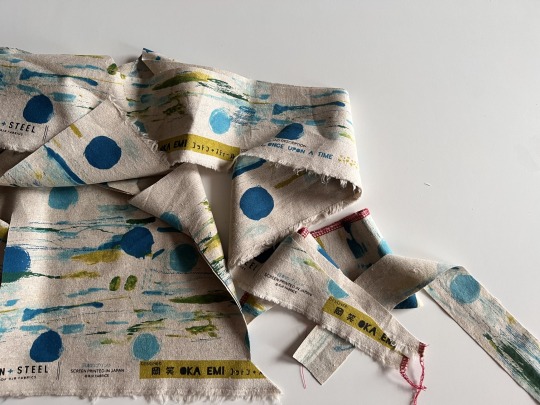#cotton and steel
Explore tagged Tumblr posts
Text
Bought some orange string to make bracelets in memory of Ariel and Kfir.
A string at one time bound us all together... This tragedy also bound us together.
I want to donate 100% of the proceeds, but am not sure where...
So if anyone has any ideas on good charities that maybe the boys would have liked or did like?
Anyways. Wishing you all the best.
#i have i think 65ft of pure cotton string#but i may try to get another size as well#i dont know if i want to add on engravings in stainless steel or not#i just like to have a plan
18 notes
·
View notes
Text

Gyro with his best pony friend Cotton Candy




13 notes
·
View notes
Text
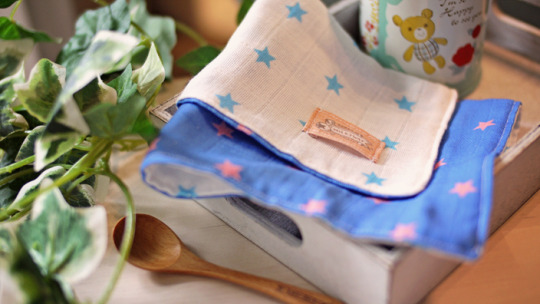


[New Drop] Special 2/3 size tea/hand towels!
Only a few available because these are from the ends of the fabrics😊 I sold out of the regular square towels long time ago so this is your only chance to get them again!
● SBR Star-spangled ● Zipperman Bruno
Custom-printed in USA on a soft organic cotton gauze that's commonly used in baby apparel��
🫖Shop🫖
#jjba#jojos bizarre adventure#bruno bucciarati#johnny joestar#steel ball run#sbr#golden wind#vento aureo#my art#hand towel#tea towel#handkerchief#organic cotton gauze#handmade
16 notes
·
View notes
Text

Brown Cotton and Steel Girl’s Crinoline, 1869, British.
Victoria and Albert Museum.
#cotton#steel#crinoline#child#1869#1860s#1860s crinoline#1860s child#1860s britain#British#brown#V&A#extant garments#1860s undergarment#1860s extant garment#undergarments
20 notes
·
View notes
Text


I need to draw Silas, but I also need to stop playing long enough to do that. ;; <3 (So obvs going to throw more photos at you in the meanwhile.)
#Going for a gunsmith/rifle build for him#He's also a plant dad/smoker (boy stop picking up cigs)/big into acoustic instruments (has a steel guitar but also partial to the banjo)#Not a fan of super mutants tbh#Has seen Mothman exactly once#and was like 'Boy just shoots right on up huh'#Like dogs but won't keep one cause of the amount of shit he gets into on the daily he'd be forever worried about the dog#Obvs not in game but he does wear a bunch of silver rings#and likes fiber based bracelets (things like cotton knots)#Tea drinker#Worked maintenance in Vault 76#Has (had?) three sisters -- they ended up in different vaults so he's still trying to work out what happened to them#Lozz blah blah#Silas blah blah
10 notes
·
View notes
Text
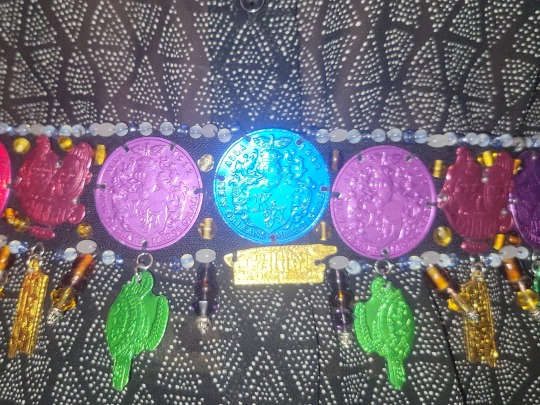

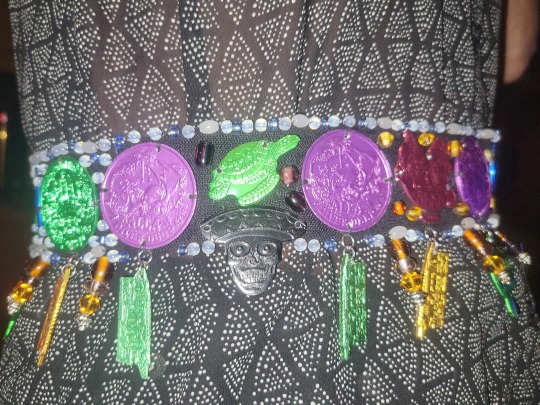
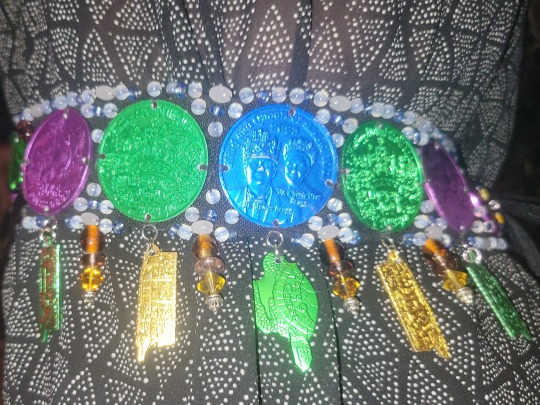
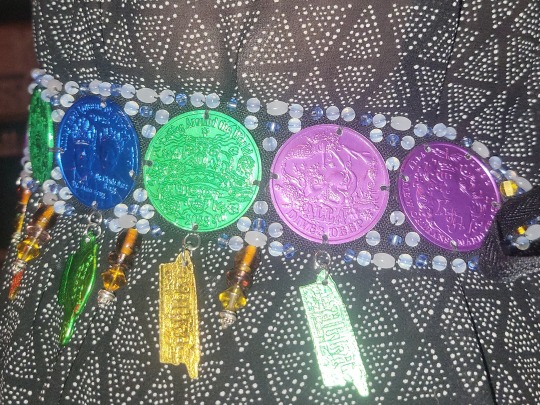

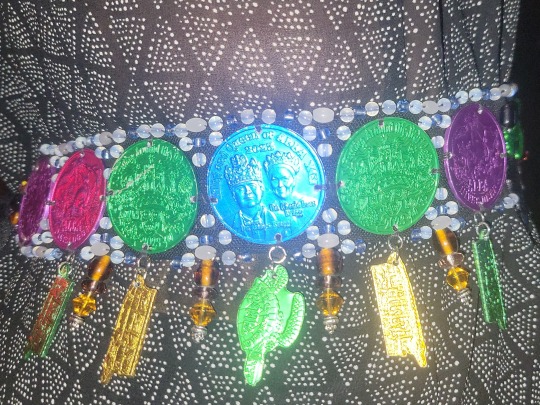


Doubloon Belt No. 2 - Krewe of ALLA
Aluminum, glass beads, linen, steel, cotton thread
Made in New Orleans in March of 2023
"Made of 2022 & 2023 Krewe of ALLA doubloons, white and blue glass beads from Krewe of Muses charm necklaces, and amber & purple glass beads from Krewe of Proteus. I plan to add onto it with new doubloons every year hanging where the ALLAgator's are (moving them to the bottom) eventually making a Roman Legionnaire style skirt. The inspiration for making the belts in the first place came because during ALLA a rider in front of me accidentally dropped their whole baggy of doubloons from the upper deck of their float. So after I passed out some to the people around me I decided that, with the exception of the 1 of each for my collection, I would to do something special with the rest of them, and this is what I came up with. ~Baron Leo James Robertson"
RobertsonIndustries etsy shop
#mardi gras#bohemian#krewe of alla#clothing#fashion#belt#mardi gras doubloons#aluminium#glass beads#linen#steel#cotton#2023
7 notes
·
View notes
Text

August 01, 2023
#amsterdam#en dat is twee#werkmansjasje#cotton+steel#klaar in een dag#zomerjasje#linnen katoen#japan
3 notes
·
View notes
Text

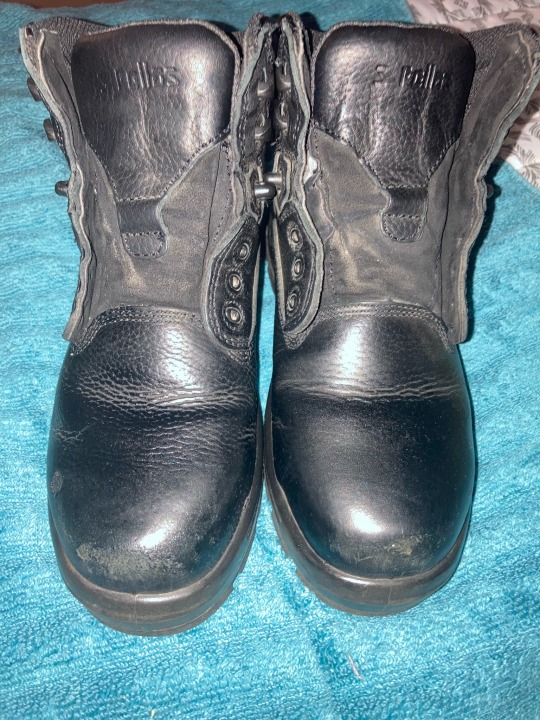


Cleaning leather boots is a form of sex
#unfortunately not shined bc I did not bring any cotton cloth……#also first ones are my steel toed work boots teehee
3 notes
·
View notes
Text
Smart Commodity Storage Structures for Farm Efficiency Breza Farming’s commodity storage structure enhances flexibility, storing cotton seed, grain, and machinery. Designed with Entegra, it ensures efficient on-farm storage, market timing benefits, and streamlined harvests. An integrated canopy expands capacity, optimizing farm operations with year-round functionality. Watch now: https://shorturl.at/ZKKOO
#commodity storage structure#grain shed#storage shed#cotton seed and grain storage#agricultural shed contruction#agricultural steel buildings
0 notes
Text
Another 5* rating for How Britain Shaped the Manufacturing World
How Britain Shaped the Manufacturing World explores the history of British manufacturing up to 1951 and its sequel Vehicles to Vaccines looks at the subsequent decades. I am now exploring the history geographically, looking at Manufacturing Places. Buy How Britain Shaped the Manufacturing World Buy Vehicles to Vaccines
#Cotton#Energy#Engineering#Festival of Britain of 1951#Great Exhibition of 1851#history#Industrial Revolution#Manufacturers#manufacturing#Pilkington#Railways#Shipbuilding#Steam#Steel#Textiles#Vickers
1 note
·
View note
Text

Shop Cotton and Steel Fabric Collection Online - Fabricanaus
Get the best deals on cotton and steel fabrics at Fabricanaus fabric store. Enjoy discounts on top brands and shop our exclusive fabric collection today!
0 notes
Text
#mcx share price#mcx cotton live#moneycontrol commodity#24 rate net live#mcx copper#goc technology bank nifty#copper mcx#steel city back office#mcx option chain#mcx share price nse#mcx copper price#mcx aluminium#copper mcx price
0 notes
Text
hoodie | sylus


summary: you just wanted to return it. but your neighbor wasn’t buying it. cw: female reader, gendered terms, neighbor au, p-in-v, cowgirl, bodily fluids, slight choking (if you squint), explicit language, size difference, sylus is a down-bad lover boy consent king who loves to please wc: 2k notes: for @leighsartworks216 and the anon who triple dog dared me to write this. tunes: keep me up - b.i


“—wanted to give it back.”
Sylus quirks a brow. Huffs a soft sound, peering at you through the wet cling of his hair. He crosses his arms, leaning against the doorframe of his apartment in an easy slouch, that customary smirk on his face.
“You wanted to give what back, sweetie?”
You swallow, studying your feet. Shift your weight between them, toying with the hem of your—his—hoodie. You pull at some loose skin on your lip with your teeth before continuing.
“Your hoodie.”
He scoffs. Gives you a once-over. “How do you expect to return it when you’re still wearing it?”
He’s asking too many questions. You make the mistake of looking at his face, your insides turning to ice.
He’s fresh out of his shower, water droplets easing down his jaw and neck from his hair. He smells divine—the broken skin of bergamot and something forresty. Looks amazing, his black t-shirt and grey sweats doing little to disguise the devastation of his body.
He studies you with a challenging gleam in his eyes. He knows, and he’s going to make you use your words tonight. He’s been doing that a lot lately—squeezing things out of you little by little. You’re in the early stages of your relationship, so he’s still trying to feel you out. Trying to see what makes you tick, slowly drawing out your wants and desires.
“I’m a pretty present wrapped up tight,” you say around a smile, shifting gears from your nervousness. You twirl around, making a heart shape overhead when you pose.
He chuckles. Sees through your attempt to change the subject, but he steps aside to let you in, anyway. You’re lucky you’re cute. Otherwise, he’d leave you in the breezeway looking like a jilted fool (he wouldn’t).
You lean against his counter like it’s your second home (it is), trying to play it cool. Watch him towel off his hair, pretty lashes curling, bicep flexing.
The sleeves of his hoodie fall past your fingertips. Its hem teases your knees. It swallows you whole in brushed cotton and stale cologne.
He gave it to you a few nights ago after your last visit. Your clothes were wet from the rain. To worsen matters, you ran out of input attempts for the keypad for your apartment. The security company didn’t come until morning to reset it. Luckily, your neighbor-turned-boyfriend was home to rescue you. To warm you up in more ways than one.
It was comical, cute, watching you tiptoe across the hall after they reset your pin the following morning, donned in nothing but Sylus’ old college hoodie. The sight stirred something primal in him. He was grateful he never threw it out—it looked better on you, anyway.
He moves your way, a flash of amusement and smoldering red. You turn away. Fiddle with some decor on his countertop, playing coy. You know what you’re doing. You’re not wearing anything underneath, are you? He senses it. The static from his proximity prickles your naked skin beneath.
He’s hot behind you. Rigid. Massive, spilling over you like liquid sin. His palms roost on the countertop, thumbs smoothing over your knuckles. The sight and size of his hands make your throat dry.
His lips brush your ear. You’re stiff as steel, biting your lip when his teeth pinch the cartilage. “You don’t need an excuse to come see me, sweetheart,” he says, breathy, voice crackling like that of a campfire. “My home is as much yours as it is mine.”
You’re dizzy. Spinning. Legs nearly give way. Lips part with a shaky breath. Instinctively, you lean away to grant him more of your neck as he roots his nose along it. Lips burn like branding irons, teasingly brushing the flexing tendons there.
“Don’t know what you’re talking about. I just wanted to give your hoodie back.”
He chuckles. The sound of it puddles between your legs. “Sure you did. And that’s why you’re bare underneath, isn’t it?”
His thumbs knead your hip bones as if to test his theory, burning through the drape of his hoodie. He exhales, open-mouthed and playful, dragging his lips over the space behind your ear, over your hair. He pushes your hips into the counter’s edge with the light roll of his pelvis, and you feel the thick of him throbbing against the cleft of your ass.
You release a breath. Eyes shutter, and you feel drunk. Okay—maybe the hoodie was a shit excuse to see him. To feel him. You could very well ask for a repeat of the other night, and he’d gladly give it to you. Doesn’t mean you don’t get to play innocent from time to time.
Emboldened, you turn. Snake your arms about his brawny shoulders, wrists crossing behind his neck. His eyes fall to your mouth. You smile something smug, ghosting your lips over his, turning the tide.
“Kiss me?” you breathe, as if it has to be asked.
“Of course,” he husks. Slides his hands down to your waist, and in one fluid motion, he lifts you onto the countertop.
It’s a cool contrast to your inflamed skin. Pales in comparison to the molten caress of his mouth, to the breath he huffs out through his nostrils as he kisses you with the fervor of a man starved.
You rake your fingers through his hair. Pull him close to you, never getting enough. No matter how much you touch or feel, it isn’t enough. He feels the same, never once breaking the union of your mouths as he hefts you into his arms to carry you deeper into his home.
You’re a mess of teeth and hair and breathiness when you fall beneath his bedroom’s ambient, amber veil. He spins you, plopping on the edge of his bed with you in his lap. His hands are everywhere, pulling, tugging, bunching. He grows even harder, the thought of his hoodie grazing over your knotted nipples, your lush thighs, the swell of your ass, driving him insane.
He pushes a bitten-off growl between your teeth. You shove him back until his spine acquaints itself with the mattress. He blinks rapidly to dispel the haze, the bleariness. Confused. The look on your face makes him twitch beneath his sweats. He loves it when you take control.
You loom over him like something predatory, the color of your eyes catching just right in the light. His fingers curl around your thighs, encouraging you closer. And he’s enamored by how the doughy flesh craters beneath them. How you lean down to siphon his breath with another kiss, rolling your body against his like the lazy lick of a wave.
He’s out of his mind—you both are. But you feel so good, pushing against him like that. You’re not wearing panties, the hot drip of your essence soaking through his sweats, intermingling with his pre-spend. You push your palms against his chest, breaking your lip-lock with a sticky click. Continue that maddening wind of your hips, leaning back on your hands fastened around his shins, and he’s drunk off the feel of you.
“Did you want to take it slow this time?” he rasps, meeting you knock for delicious knock.
He’s delirious. Swept up in the tide of pleasure as he holds your hips, but he’s still considerate. He’s desperate for you. Eager to feel you greedily sucking him in. But reassurance is his love language. He’ll ask you if you want him until he’s blue in the face.
You shake your head, sucking your lip between your teeth. Your hair falls onto your features just right. Your body burns. It’s a mystery how you can manage to look adorable yet sexy all in one breath.
“Then what are you waiting for?” he asks through a chuckle. Neediness seeps through.
He’s trying to remain in control. Trying to rein himself in. But his desire leaks through those layers of bravado, and it’s all because of you, just for you.
He’s remiss of the hot grind of your cunt when you dismount him. Don’t leave him waiting long, tugging at the rim of his sweats, the pair of you giggling and fumbling about like two enamored youths. He helps you pull them down just slightly, enough for his pretty girth to bound free. It slaps against his abs, the tip of it gleaming with a gossamer bead of pre.
You straddle him once more, lubing up his shaft with your slick. On one particular shift of your hips, your opening catches on the head of his cock, the sticky sound of the meeting obscene, and fuck. You groan in tandem, throwing your heads back at the delicious friction—the threat of a union.
Neither of you can take any more teasing. So, he helps you ease him home. Inch by maddening inch, you sink onto him. He can’t breathe. You feel so good, blanketing him like that. Pulsing around him, the swollen head of his cock kissing your cervix.
He grants you time to adjust to the intrusion. Rubs reassurance into your hips with his thumbs. His hoodie is bunched up around your middle, revealing the pretty meat of your belly. He slides his hands up the notches of your rib cage to cup your breasts. Weighs them, kneads them. Swipes his thumbs over your nipples to soothe the ache. You pulse from the feeling, wringing the prettiest sound from his throat.
You start moving when you’ve grown accustomed to his size. His heat. You take him so good, so deep. He sees stars—phosphenes dancing behind his lids. He throws his head back, catching his lip between his teeth, palms fastened to your waist. He moors you to him, rolling his hips in time with your bouncing, a practiced dance, a rehearsed symphony.
The clop of skin against skin salts the humid atmosphere of his bedroom. Your voices intermingle, his deep and crooning and praising, yours high and light and desperate.
You interweave your fingers with his, pressing his hands into the mattress beside him as you lean forward to ride him faster. His tender instruction is too much. His soft approval. A beautiful flush powders his cheeks and ears to match the soft smolder of his eyes.
“That’s it, sweetheart. Take me. Take what you want from me. Just like that. Don’t stop.”
You rock your hips just right, spurred by his guidance. Steal the air from his lungs as your clit drags against his pelvic bone with each roll. That familiar feeling sparkles between where your bodies meet. It sinks its talons into your belly, hauling itself upwards. You throw your head back as the rush spills over you. His fingers loosely clasp around your throat, your pulse rabbiting beneath his palm.
He fucks you through it, the slow, consuming creep of your orgasm, his thumb digging into your throat. You’re so beautiful when you cum. When you let yourself go like this, and you drag him into the abyss with you.
He pulls you off him in time for hot spurts of cum to adorn his hoodie, to burn your belly, to leak down your thighs. And the image of you swallowed up in it, panting, laughing, burning hot, shaking in the aftermath of your orgasm with his cum staining the faded fabric makes his heart pinch.
You lay your cheek between his pectorals as you come down, chasing the steady rhythm of your breaths. He strokes over your hair, pressing a kiss into the crown of your head, whispering encouragement into it.
“Did you still want your hoodie back?” you taunt against the unbroken thrum of his heartbeat, drawing nonsensical patterns on his chest.
His lips quirk. Still cheeky even when you’re spent. He’ll have to do a better job of tiring you out next time. There will be a next time. And another time after that.
“Keep it,” he rasps, smoothing his thumb over your cheek. “It looks better on you.”
It’s an excuse to see you again. Not like he needs one.
#sylus x reader#sylus x you#sylus x female reader#lads sylus#love and deepspace sylus#sylus#sylus smut#lnds sylus#l&ds sylus#sylus qin#qin che#lads smut
1K notes
·
View notes
Text
Ko-fi prompt from @liberwolf:
Could you explain Tariff's , like who pays them and what they do to a country?
Well, I can definitely guess where this question is coming from.
Honestly, I was pretty excited to get this prompt, because it's one I can answer and was part of my studies focus in college. International business was my thing, and the issues of comparative advantage (along with Power Purchasing Parity) were one of the things I liked to explore.
-----------------
At their simplest, tariffs are an import tax. The United States has had tariffs as low as 5%, and at other times as high as 44% on most goods, such as during the Civil War. The purpose of a tariff is in two parts: generating revenue for the government, and protectionism.
Let's first explore how a tariff works. If you want to be confused, then you need to have never taken an economics class, and look at this graph:

(src)
So let's undo that confusion.
The simplest examples are raw or basic materials such as steel, cotton, or wine.
First, without tariffs:
Let us say that Country A and Country B both produce steel, and it is of similar quality, and in both cases cost $100 per unit. Transportation from one country to the other is $50/unit, so you can either buy domestically for $100, or internationally for $150. So you buy domestically.
Now, Country B discovers a new place to mine iron very easily, and so their cost for steel drops to $60/unit due to increased ease of access. Country A can either purchase domestically for $100, or internationally for $110 (incl. shipping), which is much more even. Still, it is more cost-effective to purchase domestically, and so Country A isn't worried.
Transportation technology is improved, dropping the shipping costs to $30/unit. A person from Country A can buy: Domestic: $100 International: $60+$30 = $90 Purchasing steel from Country B is now cheaper than purchasing it from Country A, regardless of where you live.
Citizens in Country A, in order to reduce costs for domestic construction, begin to purchase their steel from Country B. As a result, money flows from Country A to B, and the domestic steel industry in Country A begins to feel the strain as demand dwindles.
In this scenario, with no tariffs, Country A begins to rely on B for their steel, which causes a loss of jobs (steelworkers, miners), loss of infrastructure (closing of mines and factories), and an outflow of funds to another country. As a result, Country A sees itself as losing money to B, while also growing increasingly reliant on their trading partner for the crucial good that is steel. If something happens to drive up the price of B's steel again, like political upheaval or a natural disaster, it will be difficult to quickly ramp up the production of steel in Country A's domestic facilities again.
What if a tariff is introduced early?
Alternately, the dropping of complete costs for purchase of steel from Country B could be counteracted with tariffs. Let's say we do a 25% tariff on that steel. This tariff is placed on the value of the steel, not the end cost, so:
$60 + (0.25 x $60) + $30 = $105/unit
Suddenly, with the implementation of a 25% tariff on steel from Country B, the domestic market is once again competitive. People can still buy from Country B if they would like, but Country A is less worried about the potential impacts to the domestic market.
The above example is done in regards to a mature market that has not yet begun to dwindle. The infrastructure and labor is still present, and is being preemptively protected against possible loss of industry to purchasing abroad.
What happens if the tariff is not implemented until after the market has dwindled?
Let's say that the domestic market was not protected by the tariff until several decades on. Country A's domestic production, in response to increased purchasing from abroad, has dwindled to one third of what it was before the change in pricing incentivized purchase from B. Prices have, for the sake of keeping this example simple, remained at $100(A) and $60(B) in that time. However, transportation has likely become better, so transportation is down to $20, meaning that total cost for steel from B is $80, accelerating the turn from domestic steel to international.
So, what happens if you suddenly implement a tariff on international steel? Shall we say, 40%?
$60 + (0.4 x 60) + 20 = $104
It's more expensive to order from abroad! Wow! Let's purchase domestically instead, because these prices add up!
But the production is only a third of what it used to be, and domestic mines and factories for refining the iron into steel can't keep up. They're scaling, sure, but that takes time. Because demand is suddenly triple of the supply, the cost skyrockets, and so steel in Country A is now $150/unit! The price will hopefully come down eventually, as factories and mines get back in gear, but will the people setting prices let that happen?
So industries that have begun to rely on international steel, which had come to $80/unit prior to the tariff, are facing the sudden impact of a cost increase of at least $25/unit (B with tariff) or the demand-driven price increase of domestic (nearly double the pre-tariff cost of steel from B), which is an increase of at least 30% what they were paying prior to the tariff.
There are possible other aspects here, such as government subsidies to buoy the domestic steel industry until it catches back up, or possibly Country B eating some of the costs so that people still buy from them (selling for $50 instead of $60 to mitigate some of the price hike, and maintain a loyal customer base), but that's not a direct impact of the tariff.
Who pays for tariffs?
Ultimately, this is a tax on a product (as opposed to a tax on profits or capital themselves, which has other effects), which means the majority of the cost is passed on directly to the consume.
As I said, we could see the producers in Country B cut their costs a little bit to maintain a loyal customer base, but depending on their trade relationships with other countries, they are just as likely to stop trading with Country A altogether in order to focus on more profitable markets.
So why do we not put tariffs on everything?
Well... for that, we get into the question of production efficiency, or in this case, comparative advantage.
Let's say we have two small, neighboring countries, C and D, that have negligible transportation costs and similar industries. Both have extensive farmland, and both have a history of growing grapes for wine, and goats for wool. Country C is a little further north than D, so it has more rocky grasses that are good for goats, while D has more fertile plains that are good for growing grapes.
Let's say that they have an equal workforce of 500,000 of people. I'm going to say that 10,000 people working full time for a year is 1 unit of labor. So, Country C and Country D have between the 100 units of labor, and 50 each.
The cost of 1 unit of wool = the cost of 1 unit of wine
Country C, having better land for goats, can produce 4 units of wool for every unit of labor, and 2 units of wine for every unit of labor.
Meanwhile, Country D, having better land for grapes, can produce 2 units of wool per unit of labor, and 4 units of wine per unit of labor.
If they each devote exactly half their workforce to each product, then:
Country C: 100 units of wool, 50 units of wine Country D: 50 units of wool, 100 units of wine
Totaling 150 units of each product.
However, if each devotes all of their workforce to the product they're better at...
Country C: 200 units of wool, no wine Country D: no wool, 200 units of wine
and when they trade with each other, they each end up with 100 units of each product, which is a doubling of what their less-efficient labor would have resulted in!
The real world is obviously much more complicated, but in this example, we can see the pros of outsourcing some of your production to another country to focus on your own specialties.
Extreme examples of this IRL are countries where most of the economy rests on one product, such as middle-eastern petro-states that are now struggling to diversify their economies in order to not get left behind in the transition to green energy, or Taiwan's role as the world's primary producer of semiconductors being its 'silicon shield' against China.
Comparative advantage can be used well, such as our Unnamed Countries (that are definitely not the classic example of England and Portugal, with goats instead of sheep) up in the example. With each economy focusing on its specialty, there is a greater yield of both products, meaning a greater bounty for both countries.
However, should something happen to Country C up there, like an earthquake that kills half the goats, they are suddenly left with barely enough wool to clothe themselves, and nothing for Country D, which now has a surplus of wine and no wool.
So you do have to keep some domestic industry, because Bad Things Can Happen. And if we want to avoid the steel example of a collapse in the given industry, tariffs might be needed.
Are export tariffs a thing?
Yes, but they are much rarer, and can largely be defined as "oh my god, everyone please stop getting rid of this really important resource by selling it to foreigners for a big buck, we are depleting this crucial resource."
So what's the big confusion right now?
Donald Trump has, on a number of occasions, talked about 'making China pay' tariffs on the goods they import into the US. This has led to a belief that is not entirely unreasonable, that China would be the side paying the tariffs.
The view this statement engenders is that a tariff is a bit like paying a rental fee for a seller's table at an event: the producer or merchant pays the host (or landlord or what have you) a fee to sell their product on the premises. This could be a farmer's market, a renaissance faire, a comic book convention, whatever. If you want to sell at the event, you have to pay a fee to get a space to set up your table.
In the eyes of the people who listened to Trump, the tariff is that fee. China is paying the United States for access to the market.
And, technically, that's not entirely wrong. China is thus paying to enter the US market. It's just the money to pay that fee needs to come from somewhere, and like most taxes on goods, that fee comes from the consumer.
So... what now?
Well, a lot of smaller US companies that rely on cheap goods made in China are buying up non-perishables while they can, before the tariffs hit. Long-term, manufacturers in the US that rely on parts and tools manufactured in China are going to feel the squeeze once that frontloaded stock is depleted.
Some companies are large enough to take the hit on their own end, still selling at cheap rates to the consumer, because they can offset those costs with other parts of their empire... at least until smaller competitors are driven out of business, at which point they can start jacking up their prices since there are no options left. You may look at that and think, "huh, isn't that the modus operandi for Walmart and Amazon already?" and yes. It is. We are very much anticipating a 'rich get richer, poor go out of business' situation with these tariffs.
The tariffs will also impact larger companies, including non-US ones like Zara (Spanish) and H&M (Swedish), if they have a huge reliance on Chinese production to supply their huge market in the United States.
If you're interested in the repercussions that people expect from these proposed tariffs on Chinese goods, I'd suggest listening to or watching the November 8th, 2024 episode of Morning Brew Daily (I linked to YouTube, but it's also available on Spotify, Nebula, the Morning Brew website, and other podcast platforms).
#id in alt text#id in alt#economics#tariffs#import tax#customs#customs duties#ko fi prompts#capitalism#phoenix talks#ko fi#taxes#taxation
2K notes
·
View notes
Text
Yandere Cyberpunk Riot Control Officer - NonCon
There's nothing he hates more than degenerates and rioters. When he gets his hands on, he's going to pound some law and order into you. Warning: general noncon, anal, abuse of authority and unorthodox baton use

Yandere! Riot Cop with his bulky body armour and faceless glass helmet. With his baton and falsely justified sense of violence.
Yandere! Riot Cop who initially runs into you when he's off duty. Who thinks you're totally his type. Who even flirts with you a little and smirks at the pretty blush he causes.
Yandere! Riot Cop who tackles you during the riot and gets one hell of a surprise when he pulls down your mask.
Yandere! Riot Cop who hates your politics, who hates that you're one of them. A girl like you should know better.
Yandere! Riot Cop who says 'degenerates' and 'anarchists' when you say 'revolutionaries.'
Yandere! Riot Cop who slams you into the concrete and bends your arm so far up your back you scream that he's going to break it.
Yandere! Riot Cop who holds you down and presses his boot into your face. His blood is way up and he gets rougher than he needs to. A little handsy too.
Yandere! Riot Cop who throws you into an unmarked police hovocraft and takes you down to the Statzi headquarters instead of to jail.
Yandere! Riot Cop who claims he wants information but who really wants to pin you down to a steel interrogation table and fuck you from behind until you're begging him to stop.
Yandere! Riot Cop who is just aching to use the excessive force you're always accusing the police of.
In custody, Yandere! Riot Cop takes you deep underground. Until you can't hear the hovocraft or the chanting of the crowds. Until you feel entirely alone.
Yandere! Riot Cop who asks his captain for permission to personally interrogate you.
Yandere! Riot Cop who who takes you to a stark, bare room and chains your wrists to the interrogation table.
You're a nobody now, he tells you. Just another terrorist. He can keep you in here for as long as he wants. Hell, even his boss doesn't care what he does, as long as he keeps you alive.
Yandere! Riot Cop who gives you a choice - give up your allies or stay here and suffer.
Yandere! Riot Cop who grins like a cat with the cream when you put on a brave face and tell him to fuck off. You're a scared little girl caught up in a bigger mess than you realise and he's going to take full advantage of it.
Yandere! Riot Cop who grabs the back of your neck and forces you down onto the table, cold steel biting into wrists and his fingers biting into your skin.
Yandere! Riot Cop who is so much stronger than you. Who has years of training that let's him maneuver you however he pleases.
And you bent over the dull steel of the interrogation table pleases him plenty.
Yandere! Riot Cop who tuts at your attempts to get away. So weak... Did you really think you could challenge the State?
Yandere! Riot Cop who slams his baton against the table right next to your face. It sounds like a gunshot in the quiet of the room.
Yandere! Riot Cop who loves the way you jump and tense up. Is it finally sinking in? It's just you and him and right now he holds all the power.
Yandere! Riot Cop who slowly runs his baton up and down your thighs. Who goes a little higher each time.
He can't mean to go through with it, you think desperately. There's cameras, there's records, there's the law for God's sake.
Yandere! Riot Cop who uses the tip of his baton to flip your skirt up and over, so your ass is bare. Who rubs one gloved hand over your cheeks. The material is cool and rough and nothing you do can shake off his touch.
Yandere! Riot Cop who let's his baton climb even higher, until the thick rubber tip is rubbing against your good girl cotton panties.
Yandere! Riot Cop who gives you one last chance to give up information. Who laughs when you tell him what he's doing is illegal. You're a terrorist, remember? You don't have rights.
Yandere! Riot Cop who pulls your panties aside with two fingers and nudges the baton against your entrance. Who takes in the site of you and savours it. A filthy rebel entirely at his mercy.
Yandere! Riot Cop who slowly pushes his baton into your cunt. The rubber is cold and unyieldingly hard, the shaft thicker than it looked.
Yandere! Riot Cop who pulls back out and sets a slow, drawn out pace. He's as implacable as a machine, never letting the pace drop because he knows your body will respond to it eventually, no matter how much you try and fight it. Who puts his free hand on your lower back and shoves you against the table when you try and squirm away.
Yandere! Riot Cop whose cock is so rock hard he can barely think. Who grips onto his baton so tightly the handle creaks from strain.
Yandere! Riot Cop who loves watching you scrunch up your nose and try not to cry. You brought this on yourself and he's enjoying every second of it.
Yandere! Riot Cop who can see your pussy getting wetter, can see the way your thighs shake. Who isn't surprised at all when you finally come, biting your bottom lip to keep your moans quiet.
Yandere! Riot Cop who gives your ass a hard squeeze, sucking air through his teeth when your skin turns red under his hand. You look so damn good like this - skirt up, ass blushing, pussy dripping. And you're all his.
You cunt is an aching mess and your hair sticks to your cheeks in damp strands, and still you refuse to talk.
Yandere! Riot Cop who feels every sadistic instinct rising up to play.
Yandere! Riot Cop who tears a condom open with his teeth.
Yandere! Riot Cop who rubs his tip against your tight little asshole. There isn't any lube besides the juices from your pussy and whatever came with the condom but he's far past the point of caring - if he had one to begin with.
Yandere! Riot Cop who grabs his cock with one hand and your handcuffs with the other. It's a damn struggle to push into your ass and when the tip is in, he throws his head back and groans.
You're unbelievably, unbearably tight.
Yandere! Riot Cop who finally has enough leverage to go all the way. Who plants his hands on either side of your face and forces himself in with a brutal thrust.
Yandere! Riot Cop who loves the way you scream.
He's fucking huge. It feels like your whole body is being stretched to its limit. When he pulls almost all the way out and slams himself back in, the shock makes you sob. Finally, you give in. Beg him to stop and you'll tell him whatever he wants.
Yandere! Riot Cop who's honestly impressed you lasted this long. Who pulls out almost all the way but keeps the tip inside you.
Names, he demands.
And you give them to him. Student leaders, writers, underground information runners...
It's betrayal, pure and simple. But in this empty room, miles from the open sky, your comrades and your cause feel irrelevant.
They aren't here with you. He is.
Yandere! Riot Cop who gives a satisfied purr, his hands cradling your waist. See? That wasn't so hard, was it?
Yandere! Riot Cop who can feel you finally relaxing.
Yandere! Riot Cop who uses it as an opportunity to snap his hips forward and bury his cock in you again.
"The first bit for was interrogation. The rest is just for me."
Yandere! Riot Cop who grabs your hair the entire time he's railing you, the other hand on your handcuffs to pull you back onto his dick with every thrust.
Yandere! Riot Cop who tells you to scream as much as you can, the people who can help you can't hear you and the people who can hear you won't help you.
Yandere! Riot Cop who fucks like a stallion and growls like a dog.
Yandere! Riot Cop who can feel you orgasm again with the nerves his hitting. Your ass and cunt both shivering around him. He's giving you the worst sort of pain and the worst sort of pleasure at the same time.
Yandere! Riot Cop who pulls your hair until you're practically bent backwards, his voice a rusty growl right in your ear when he comes.
Yandere! Riot Cop who smashes you face into the table when he's done and lifts up his visor just to whisper to you.
Yandere! Riot Cop who tells you that you don't even know who he is. He could be your neighbour or your friend's boyfriend or even someone you flirt with at the gym.
You'll never know who fucked you and you'll be filled with dread about every man you take to bed.
Yandere! Riot Cop who drawls that he might pay you a visit. He knows exactly who you are now, and such a tight little ass shouldn't be wasted on degenerates and rebels.
"Well sweetheart, how does it feel to really get fucked by the State?"
#I actually hate him#He's getting put against the wall as soon as the revolutionaries win#yandere blog#yandere x reader#yandere imagines#yandere scenarios#yandere drabbles#yandere#reader insert#x reader#yandere oc#Riot Police#Riot Control Officer#Yandere Cop
1K notes
·
View notes
